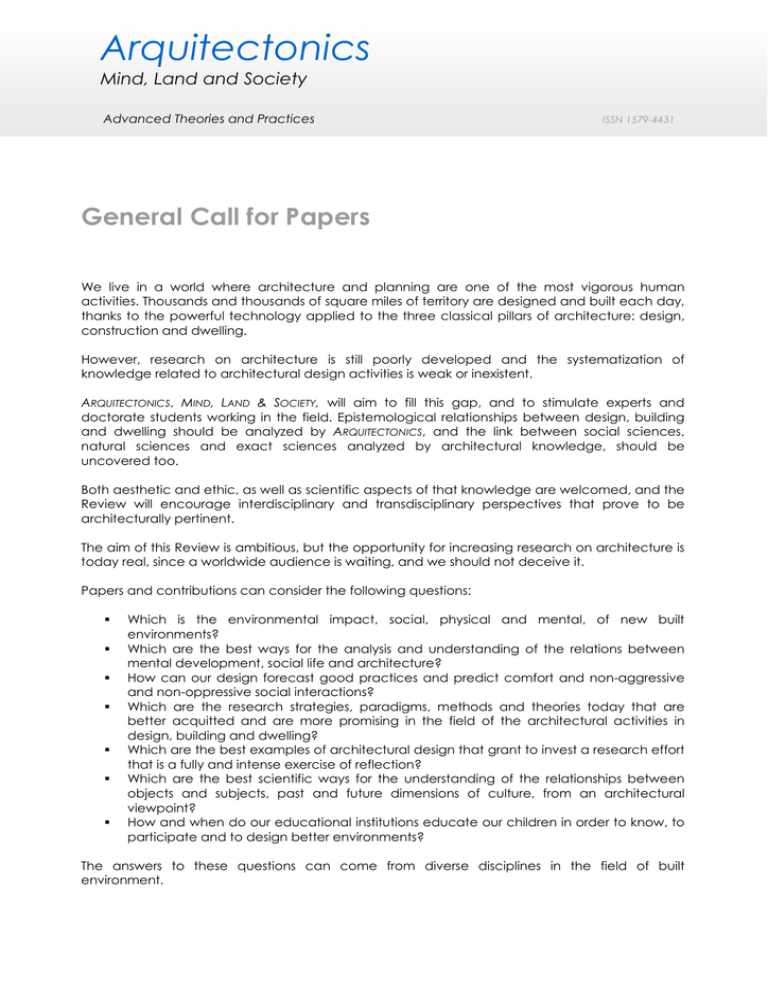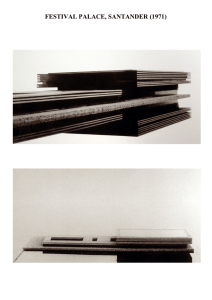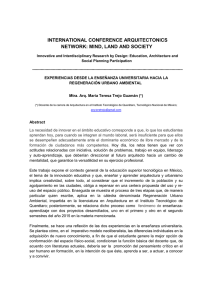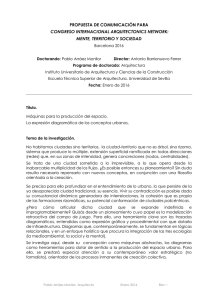Call for Papers II
Anuncio

Arquitectonics Mind, Land and Society Advanced Theories and Practices ISSN 1579-4431 General Call for Papers We live in a world where architecture and planning are one of the most vigorous human activities. Thousands and thousands of square miles of territory are designed and built each day, thanks to the powerful technology applied to the three classical pillars of architecture: design, construction and dwelling. However, research on architecture is still poorly developed and the systematization of knowledge related to architectural design activities is weak or inexistent. ARQUITECTONICS, MIND, LAND & SOCIETY, will aim to fill this gap, and to stimulate experts and doctorate students working in the field. Epistemological relationships between design, building and dwelling should be analyzed by ARQUITECTONICS, and the link between social sciences, natural sciences and exact sciences analyzed by architectural knowledge, should be uncovered too. Both aesthetic and ethic, as well as scientific aspects of that knowledge are welcomed, and the Review will encourage interdisciplinary and transdisciplinary perspectives that prove to be architecturally pertinent. The aim of this Review is ambitious, but the opportunity for increasing research on architecture is today real, since a worldwide audience is waiting, and we should not deceive it. Papers and contributions can consider the following questions: Which is the environmental impact, social, physical and mental, of new built environments? Which are the best ways for the analysis and understanding of the relations between mental development, social life and architecture? How can our design forecast good practices and predict comfort and non-aggressive and non-oppressive social interactions? Which are the research strategies, paradigms, methods and theories today that are better acquitted and are more promising in the field of the architectural activities in design, building and dwelling? Which are the best examples of architectural design that grant to invest a research effort that is a fully and intense exercise of reflection? Which are the best scientific ways for the understanding of the relationships between objects and subjects, past and future dimensions of culture, from an architectural viewpoint? How and when do our educational institutions educate our children in order to know, to participate and to design better environments? The answers to these questions can come from diverse disciplines in the field of built environment. CALL FOR PAPERS We invite you and your PhD students, or research partners, to publish in this review throughout a competitive process of selection for excellence. The first step is to send an abstract of three pages by email to the following address: [email protected] or by fax +0034 934016393 (please, indicate “ARQUITECTONICS, MIND, LAND & SOCIETY”). The abstract can be written in English, French or Spanish. We will answer if it is taken into consideration and you should then send the full text, about 12 pages in two languages. Remember that ARQUITECTONICS, MIND, LAND & SOCIETY will consider a high quality in the text by blind reviewers and by the direct supervision of the editorial board. Proposals for publication should attain then high standards of excellence, and should represent a significant contribution in the field of architectural research on worldwide. THEMATIC SPECIFIC CALL FOR PAPERS NEW ALTERNATIVE WAYS ON URBAN PLANNING This issue of Arquitectonics will focus on the scientific productions considered to be the most innovative within the particular field of epistemological turmoil, where we find some theoretical perspectives in urban planning that develop new strategies of knowledge, and performance on the urban phenomenon today. We refer to the approaches focusing on the understanding of the urban environment as a complex and multidimensional sociophysical reality from a critical aim of developing an environmental vision sensitive to social sciences, of incorporating strategies of communicative planning, of strategical vision, and of building up knowledge by incorporating the perceptions, values and interests of the social actors. We will put our attention to the innovative theoretical contributions within this disciplinary scene that is under full construction, and where we find the generically called “new alternative ways on urban planning”. This approach is characterized by its transdisciplinarity, metareadings, dialogy between different fields of knowledge, assumption of urban reality as man-environment full of configurative and symbolic identity, as a result of a historical otherness between natural and cultural environments, where each fragment of the territory acts as a necessary sociophysical unity full of cultural and architectural meaning. We will focus on the papers that suggest intertextual articulations, metacultures, dialogy, pointing to theoretical and technical resources with roots in different fields of knowledge as: sociology, anthropology, economics, environmental psychology, semiotics, architecture, urban and human ecology, history, political science, geography, agronomy, hidrology, among others…, using these as complementary perspectives in the aim to develop a complex interpretative and architectural vision of the urban environment. The editorial committee of Arquitectonics finds these questions relevant within a renewed epistemological environment under full construction that is perceived in urban planning, and that should be strengthened by scientific dissemination and linking among researchers on this field. This is the aim of this Call for Papers addressed to those who aim to generate knowledge by presenting papers on hypothetical or applied developments of cognoscitive and technical strategies suitable for “new alternative ways on urban planning” as described above. Marcelo Zárate, Architect THE INSTITUTION OF CONTEXT PROPOSAL OF CONTENT FOR ARQUITECTONICS: MIND, LAND & SOCIETY The idea to develop an issue of the ARQUITECTONICS review is based on the elaboration of the concept of institution as defined by Michel Foucaoult in “The Order of Discourse”, as a possibility of general structure of reference – context – of architectural design. The architecture conceived as a system structured of discontinuities or series of discontinuities, designs, that constitute themselves in con-text from where each new individual contribution occupies its place. The context, conceived as temporality, as placing designs, any design, in time, within the temporal series of discontinuities. In other words, to what extent do for example the building VPRO of MVRDV, or the REHAB of Herzog and De Meuron pertain to the series of discontinuities possibly opened by Le Corbusier in ville Savoye. The institution conceived in this sense conforms with the context of any architecture, which finds here its place and gives importance to this idea, essential for the evolution of permanence and change, even for those architects whose designs are ahead of their time, that are, after all, extemporary. Reflection and taking to its limits the difficult relation between invention and convention would be the base of this proposed debate. Alfred Linares, Architect CRITICISM AND ARCHITECTURE INTERPRETATION OF THE IDENTITY OF PLACE In our times, characterized by many tendencies, opinions and interpretations in the architectural field, the Editorial Committee of the International Review ARQUITECTONICS, Mind, Land and Society, Advanced Theories and Practices, looks for critical contributions on works of architecture that can be linked to public or common spaces, based on the historical, social and cultural study of the place. This permits us to involve here other applicable areas of knowledge that can help to identify the sense of local identity in the work. Architectural criticism, in general, aims to place the new object in a particular historical context, which allows to uncover the type of trend or tendency the author pertains to, and that shows his/her influence on it. This contextual research can address both the past, looking for theories, origins or precedents, and the present, reading the object from contemporary perspectives, pointing to texts of renowned authors and relating here other disciplines. The critical work within this field, traditionally, also means a thorough and detailed analysis of the work in itself, formally speaking, mechanisms of composition, spatial characteristics, functional aspects, routes, perceptions, structural elements and the materials used in its construction. However, we often forget that each architectural fact is inserted in a place, with certain physical, morphological and environmental characteristics. The building is aimed at a specific type of public, according to its function, and it addresses a certain kind of society, with its traditions and interests, both individuals and communities. The territory in where it is built is governed by particular political and economic mechanisms, and, in short, the architectural object becomes part of a reality, an urban context placed in a specific moment of history, and subsequently it will pertain to the memory of the place, to its own identity. This reality in where architecture is inserted, calls for its interpretation in terms of a local identity that represents collective interests, cultural aspects and the sense of membership, of coexistence. Identity is not static, it is dynamic and it is changing according to the change of history, and it is influenced by many elements and happenings; and architecture, as well as the public and urban spaces defined by it, are fundamental elements, which can relate the processes of social or political transformations that happen in the place. Architecture, seen as a historical element, becomes a reference that shows how it was designed, how it was built and how its function, shape and interpretation changed through time, due to its permanence within the historical processes. This permits a broader reading in relation to social and cultural referents and not only a criticism based entirely on architectural theories. In this special edition of ARQUITECTONICS, we wish to establish a mechanism of intercultural interchange that allows to enrich our professional practice, with the contribution of articles on interpretations based on the concept of identity and on the social or cultural referents. Beatriz Ramírez Boscán. Architect ARQUITECTONICS, MIND, LAND AND SOCIETY ISSN1579-4431 Arquitectonics Mind, Land and Society Advanced Theories and Practices ISSN 1579-4431 Petición General de Artículos Vivimos en un mundo donde la arquitectura y la planificación son una de las actividades humanas más vigorosas. Miles y miles de kilómetros cuadrados de territorio están proyectados y construidos cada día, gracias a la poderosa tecnología aplicada a los tres pilares clásicos de la arquitectura: el proyecto, la construcción y el habitar. Sin embargo, la investigación sobre la arquitectura aún se encuentra escasamente desarrollada y la sistematización del conocimiento relacionada con las actividades del proyecto arquitectónico es débil o no existe. ARQUITECTONICS, MENTE, TERRITORIO Y SOCIEDAD, intentará cubrir este hueco, y estimular a los expertos y a los estudiantes de doctorado que están trabajando en este campo. Las relaciones epistemológicas entre proyecto, construcción y habitar han de ser analizadas por ARQUITECTONICS, y las relaciones entre ciencias sociales, ciencias naturales y ciencias exactas, gracias al conocimiento arquitectónico deben, también, ser estudiadas. Tanto la dimensión estética, como la ética, como los aspectos científicos de este conocimiento, serán bienvenidos, y la revista alentará perspectivas interdisciplinarias y transdisciplinarias que resulten arquitectónicamente pertinentes. La revista interrogará, así mismo en qué sentido la arquitectura es una interfase entre el hombre, la sociedad y sus territorios. El objetivo de esta revista es ambicioso, pero la oportunidad para incrementar la investigación sobre arquitectura es hoy real, la población mundial lo está esperando y no la deberíamos decepcionar. Vuestras aportaciones deberán considerar las siguientes problemáticas: • • • • • • • ¿Cómo impactan en la vida individual y colectiva las transformaciones de nuestras ciudades y nuestros territorios? ¿Cómo y cuando nuestras instituciones educativas influyen en la capacidad de los niños y niñas para imaginar, usar y conocer los mejores medio ambientes para construir en un próximo futuro? ¿Cuales son los mejores caminos y mejores métodos para analizar y comprender las relaciones entre el desarrollo mental, vida social y arquitectura. ¿Cómo podemos predecir a través de los proyectos de arquitectura un buen y confortable uso del espacio social? ¿Cuales son las mejores teorías y los mejores paradigmas que existen hoy en día, en el campo de la investigación en arquitectura? ¿Qué ejemplos de proyectos y de construcciones de hoy se merecen un esfuerzo de investigación y reflexión a su través, y por qué? ¿Cuales son los mejores paradigmas científicos para comprender las relaciones entre objetos y sujetos, pasado y futuro como dimensión cultural en la arquitectura? Las respuestas a estas preguntas pueden venir de diferentes disciplinas dentro del campo de la arquitectura y del entorno construido. PETICIÓN DE ARTÍCULOS Por lo tanto, les invitamos a Uds., a sus estudiantes y a sus colaboradores en la investigación, a publicar en esta revista a través de un proceso de selección en busca del máximo de calidad. El primer paso, es enviar un resumen de tres páginas de la contribución que desea hacerse por e-mail a la siguiente dirección: [email protected] o por fax +0034 934016393, indicando “ARQUITECTONICS, MENTE, TERRITORIO Y SOCIEDAD”. Este resumen puede enviarse en español, en inglés o en francés. Contestaremos si este ha sido aceptado y luego deberá enviarse el artículo completo, de hasta 12 páginas, escrito en dos idiomas. Recordamos que la revista quiere alcanzar un alto grado de excelencia y que, por lo tanto, los textos aceptados deberán corregirse y perfeccionarse cuanto sea necesario. PETICIÓN ESPECÍFICA DE ARTÍCULOS: URBANISMO ALTERNATIVO El interés de la presente convocatoria está orientado a editar un número de la Revista ARQUITECTONICS especialmente dedicada a indagar en las producciones científicas consideradas más innovadoras dentro del particular ambiente de ebullición epistemológica en el que se encuentran algunas perspectivas teóricas en urbanismo, interesadas en desarrollar nuevas estrategias de conocimiento y actuación sobre el fenómeno urbano contemporáneo. Se hace particular referencia a aquellas perspectivas interesadas en comprender el ambiente urbano como un hecho sociofísico complejo y multidimensional desde el intento crítico de desarrollar una visión ambiental sensible a las ciencias sociales, de incorporar estrategias de planificación comunicativa, de visión estratégica y de construir conocimiento a partir de la incorporación de las propias percepciones, valoraciones y juegos de intereses de los actores sociales. De este modo se pretende detectar aportes teóricos innovadores dentro de un panorama disciplinar en plena construcción dentro del aquí genéricamente denominado “urbanismo alternativo” cuyo rasgo característico es la transdisciplinariedad, las metalecturas, la dialogía entre campos diversos del conocimiento, la asunción del hecho urbano como ambiente del hombre cargado de identidad configurativa y simbólica, como resultado de una alteridad histórica entre ambiente natural y cultural, en el que cada fragmento del territorio actúa como una unidad sociofísica inescindible cargada de sentido cultural y proyectual. Interesa detectar respuestas con la característica común de proponer articulaciones intertextuales, metaculturas, dialogía, a partir de recursos teóricos y técnicos provenientes de los más diversos campos del conocimiento tales como: sociología, antropología, economía, psicología ambiental, semiótica, arquitectura, ecología urbana y humana, historia, ciencia política, geografía, agronomía, hidrología, entre otras…, a los cuales se los solicita como perspectivas complementarias en el intento de desarrollar una visión interpretativa y proyectual compleja del ambiente urbano. El comité editorial de ARQUITECTONICS considera a esta una problemática relevante dentro de un renovado ambiente epistemológico que se percibe en urbanismo en plena construcción al que resulta alentador robustecer posibilitando la difusión y vinculación científica entre los que trabajan por ello. Esto es el espíritu de la presente convocatoria para quienes con clara intención de generación de conocimiento quieran presentar papers referidos a desarrollos hipotéticos o aplicados de estrategias cognoscitivas y técnicas propias de un “urbanismo alternativo” tal como se lo caracterizara anteriormente. Marcelo Zárate, Arquitecto LA INSTITUCIÓN DEL CONTEXTO PROPUESTA DE CONTENIDO PARA ARQUITECTONICS: MIND, LAND & SOCIETY La idea para desarrollar un número de la revista ARQUITECTONICS, se basa en pensar el concepto de institución tal como lo define Michel Foucaoult en “El orden del discurso”, como posibilidad de estructura general de referencia – contexto – del proyecto de arquitectura. La arquitectura concebida como un sistema estructurado de discontinuidades o series de discontinuidades, los proyectos, que se constituyen ellos mismos en con-texto a partir del cual cada nueva aportación individual, ocupa su sitio. El contexto, concebido como temporalidad, como poner en tiempo los proyectos, cualquier proyecto, dentro de las series temporales de discontinuidades. En otros palabras, hasta qué punto por ejemplo el edificio VPRO de MVRDV, o el REHAB de Herzog y De Meuron, pertenecen a la serie de discontinuidades inaugurada probablemente por Le Corbusier a la ville Savoye. La institución concebida en este sentido se conforma como el contexto de cualquier arquitectura, que encuentra en ella su sitio y da sentido importante a aquella idea, esencial para la evolución de permanencia y cambio, incluso para aquellos arquitectos de los cuales sus proyectos se adelantan en el tiempo, que son en definitiva extemporáneos. Reflexionar y llevar hasta sus límites la relación difícil, entre invención y convención estaría en la base del debate propuesto. Alfred Linares, Arquitecto. CRÍTICA Y ARQUITECTURA INTERPRETACIÓN DE LA IDENTIDAD DEL LUGAR En nuestra época actual, caracterizada por múltiples tendencias, opiniones e interpretaciones respecto al campo de la arquitectura, el comité editorial de la revista ARQUITECTONICS, Mind, Land and Society, Advanced Theories and Practices, busca la aportación crítica sobre obras de arquitectura, que pueden estar vinculadas a espacios públicos o comunitarios, basada en el estudio histórico, social y cultural del lugar. Esto permite involucrar para ello, otras áreas aplicables del conocimiento, que puedan ayudar a identificar el sentido de identidad local en la obra. La crítica arquitectónica, en general, busca ubicar el nuevo objeto dentro de un contexto histórico determinado, que permita descubrir el tipo de corriente o tendencia a la cual pueda estar afiliado el autor, y que demuestre su influencia sobre el mismo. Esta investigación contextual puede dirigirse tanto al pasado, buscando teorías, orígenes o precedentes; como hacia el presente, realizando la lectura del objeto en términos contemporáneos, basada en textos de autores reconocidos y relacionando para ello otras disciplinas. El trabajo crítico dentro de este campo, tradicionalmente, también comprende un análisis exhaustivo y detallado de la obra en sí, en términos formales, mecanismos de composición, características espaciales, aspectos funcionales, recorridos, percepciones, elementos estructurales y materiales empleados en su construcción. Sin embargo, muchas veces olvidamos que cada hecho arquitectónico se encuentra inserto en un lugar, con ciertas características físicas, morfológicas y ambientales. El edificio se destina a un público específico, de acuerdo a su función y está orientado a una determinada sociedad, con sus costumbres e intereses, tanto individuales como colectivos. El territorio donde se emplaza, se encuentra regido por mecanismos políticos y económicos específicos y, en resumen, el objeto arquitectónico pasa a formar parte de una realidad, un contexto urbano ubicado en un momento dado de la historia y luego llega a pertenecer a la memoria del lugar, a su propia identidad. Esta realidad donde se inserta la arquitectura, exige su interpretación en términos de una identidad local, que represente los intereses colectivos, los aspectos culturales y el sentido de pertenencia, de convivencia. La identidad no es estática, es dinámica y va cambiando según cambia la historia y se ve influenciada por múltiples elementos y sucesos; y la arquitectura, así como los espacios públicos y urbanos que ella define, son elementos fundamentales, que pueden relatar los procesos de transformación social o política que sucedan en el lugar. La arquitectura, vista como un elemento histórico, se convierte en una referencia que muestra como ésta fue diseñada, como se construyó y cómo su función, forma e interpretación cambió a través del tiempo, debido a su permanencia dentro de los procesos históricos. Esto permite una lectura más amplia en cuanto a referentes sociales y culturales y ya no una crítica basada únicamente en teorías arquitectónicas. Es el interés de la revista ARQUITECTONICS, en ésta, su edición especial, establecer un mecanismo de intercambio intercultural, que permita enriquecer nuestro ejercicio profesional, con la aportación de artículos sobre interpretaciones basadas en el concepto de identidad y en los referentes sociales o culturales que la determinan. Beatriz Ramírez Boscán, Arquitecto. ARQUITECTONICS, MENTE, TERRITORIO Y SOCIEDAD ISSN1579-4431 ARQUITECTONICS MIND, LAND & SOCIETY BOOKS, NEWSLETTER & DOSSIERS DE RECERCA, ADVANCED THEORIES AND PRACTICES ISSN: 1579-4431 Editor: Josep Muntañola. Barcelona Associate Editors: Magda Saura. Barcelona Alfred Linares. Barcelona Assistent Co-Editors: Beatriz Ramírez. Universidad de los Andes. Mérida. Venezuela Marcelo Zárate. Universidad Nacional del Litoral. Santa Fe. Argentina Ruth Marcela Diaz, Samuel Jaimes Botía . Universidad Santo Tomás, Bucaramanga. Colombia Nadya Nenadich. Universidad Politécnica de Puerto Rico. Puerto Rico Editorial Board: Board of Advisory Editors (Scientific Committee): (alphabetical order) Botta, Mario; Architect, Switzerland Boudon, Pierre; Architect, Canada Bilbeny, Norbert; Philosopher, Spain Carbonell, Eudald; Archaeology, Spain Fernández Alba, Antonio; Architect, Spain Ferrater, Carlos; Architect, Spain Gómez Pin, Víctor; Philosopher, Spain Heikkinen, Mikko; Architect, Finland Kalogirou, Nikolaos; Architect, Greece Langer, Jonas; Psychologist, USA Levy, Albert; Architect, France Lagopoulos, Alexandros; Urban Planner, Greece Mack, Mark; Architect, United States Messori, Rita; Philosopher, Italy Moore, Gary T; Architect, Australia Mul, Jos de; Philosopher, The Netherlands Pallasmaa, Juhani; Architect, Finland Ponzio, Augusto; Philosopher, Italy Preziosi, Donald; Anthropologist and Linguist, USA/UK Provensal, Danielle; Anthropologist, Spain Rapoport, Amos; Architect, USA Rewers, Eva; Philosopher, Poland Romañà, Teresa; Pedagogue, Spain Salmona, Rogelio; Architect, Colombia † Sanoff, Henry; Architect, USA Scandurra, Enzo; Urban Planner, Italy Solaguren, Félix; Architect, Spain Tagliabue & Miralles, Architects, Spain Valsiner, Jaan; Psychologist, USA Werner, Frank; Historian, Germany Institutions that support the review: Universitat Politècnica de Catalunya. Dep. Projectes Arquitectònics. Grup de Recerca GIRAS. Barcelona, Spain Universidad de los Andes. Mérida, Venezuela Universidad Nacional del Litoral. Santa Fe. Argentina Universidad de Santo Tomás. Bucaramanga. Colombia. Universidad Politécnica de Puerto Rico. Puerto Rico Corporación HEKA. Ecuador. Colegio Nacional de Arquitectos del Ecuador. Quito. Ecuador ARQUITECTONICS is included in the following catalogues: Avery Library Columbia University Catalogue. USA School of architecture Paris-la-Villette Library Catalogue. France Library of Congress Catalogue. USA. http://catalog.loc.gov Zurich Polytechnic School of architecture Library Catalogue. Switzerland Escola Tècnica Superior d’Arquitectura de Barcelona Library Catalogue. http://bibliotecnica.upc.es/ Trondheim School of architecture Library Catalogue. Norway The ARQUITECTONICS Series is in the web www.edicionsupc.es The Arquitectonics Series can be ordered through the webs: www.agapea.com - www.parisvalencia,com - http://buecher.a.get-me-books.de


